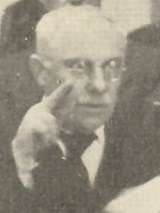Yugoslavian parliamentary election, 1938
| | |||||||||||||||||||||||||||||||||||
| |||||||||||||||||||||||||||||||||||
| |||||||||||||||||||||||||||||||||||
| |||||||||||||||||||||||||||||||||||
 |
| This article is part of a series on the politics and government of Yugoslavia |
| Administrative divisions |
Parliamentary elections were held in Yugoslavia on 1 December 1938.[1] The result was a victory for the governing Yugoslav Radical Union, which won 306 of the 373 seats in Parliament.
Coalitions
The Yugoslav Radical Union was an alliance of the People's Radical Party led by Milan Stojadinović, the Yugoslav National Party led by Bogoljub Jevtić, the Yugoslav Muslim Organization led by Mehmed Spaho and the Slovene People's Party led by Anton Korošec.
The United Opposition consisted of:
- The Croatian Peasant Party led by Vladko Maček
- The Independent Democratic Party led by Srđan Budisavljević
- The People's Radical Party led by Aca Stanojević
- The Democratic Party led by Ljubomir Davidović
- The Agrarian Party led by Jovan Jovanović Pižon
- The Montenegrin Federalist Party led by Sekula Drljević
Results
| Party | Votes | % | Seats | +/– |
|---|---|---|---|---|
| Yugoslav Radical Union | 1,643,783 | 54.1 | 306 | +3 |
| United Opposition | 1,364,524 | 44.9 | 67 | 0 |
| Yugoslav National Movement | 30,734 | 1.0 | 0 | 0 |
| Total | 3,039,041 | 100 | 373 | +3 |
| Registered voters/turnout | 4,080,286 | 74.5 | – | – |
| Source: Nohlen et al. | ||||
References
- ↑ Dieter Nohlen, Dolf Sternberger, Bernhard Vogel, Klaus Landfried (1969) Die Wahl der Parlamente und andere Staatsorgane, Walter de Gruyter, p784
External links
This article is issued from Wikipedia - version of the 9/10/2016. The text is available under the Creative Commons Attribution/Share Alike but additional terms may apply for the media files.

